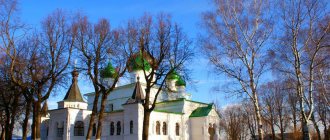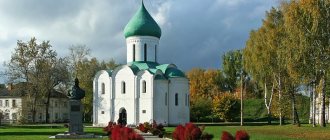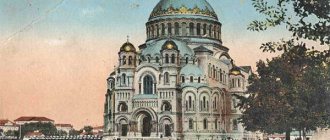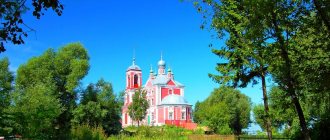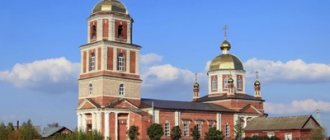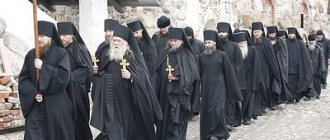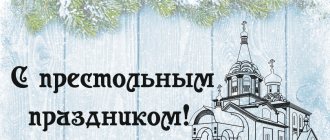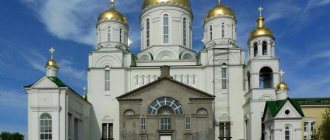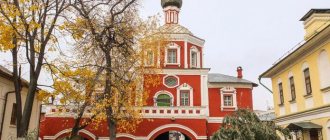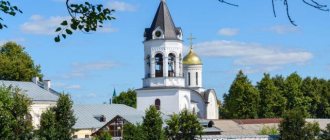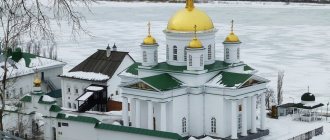History of the formation of the Nikolsky Monastery
The monastery was founded in 1348 by Dmitry Prilutsky, who was born in Pereslavl.
, who came from a wealthy merchant family. He took monastic vows in Pereslavl, at the Goritsky Monastery. There he also became a priest. After the founding of the new monastery, Dmitry Prilutsky became its abbot.
He knew Sergius of Radonezh well and was spiritually close to him. In addition, Dmitry Prilutsky was the godfather of the children of Grand Duke Dmitry Donskoy.
The place where the new, initially wooden monastery grew, was low-lying, swampy and overgrown with bushes and trees. Therefore, in old documents the monastery is often called the St. Nicholas Monastery on the Swamp. He immediately gained fame and attracted many believers.
Cathedral of St. Nicholas the Wonderworker
In subsequent centuries, great trials awaited this Christian monastery, and it was completely ruined several times. In the 80s of the 14th century, Khan Tokhtamysh, after the sack of Moscow, sent his troops to the north. Along with other Russian cities, Pereslavl was destroyed. According to historian N.M. Karamzin, some of the residents managed to escape only by sailing on rafts and boats to the middle of Lake Pleshcheevo. Then the monks returned to the ashes and rebuilt the monastery.
A quarter of a century later, Emir Edigei, who replaced Tokhtamysh, again burned Pereslavl, and with it all its monasteries. The monastery was restored already during the reign of Vasily III. This was a time when scattered principalities gathered under the rule of a single center - Moscow. By the will of the Moscow prince in 1505, the monastery was granted large state lands. And documentary evidence from those years describes the monastery as prosperous.
Cathedral of St. Nicholas the Wonderworker side view
The Time of Troubles, when False Dmitry ruled, did not bypass Pereslavl. And in 1609, Polish-Lithuanian troops plundered and burned the monastery buildings. But the desolation did not last long. Four years later, Elder Dionysius began reviving the monastery.
At the end of the 17th century, the monks became the owners of one of their most revered shrines - the Korsun cross. According to documents, only 10 similar crosses were made, and this happened in the 10th century.
The crosses were delivered by Grand Duke Vladimir Svyatoslavovich from Chersonesus to Kyiv. All of them contained particles of the relics of 19 holy saints. Chersonesos was then called Korsun. That’s why the crosses were called Korsun crosses. The holy cross and icon with the face of St. Nicholas are still in the St. Nicholas Monastery today and are highly revered by believers.
Church of Peter and Paul
The year 1667 brought new trials to the monastery. A terrible plague epidemic came to Pereslavl, which very quickly claimed the lives of nine-tenths of the entire city population. The St. Nicholas Monastery was also seriously damaged, and its territory was again deserted for a short time. Then, in 1693, the monks erected a cathedral tented bell tower. And in 1721 they completed the construction of the five-domed brick Cathedral of St. Nicholas. It took a long time to build – more than 40 years.
Circumstances were such that by the end of the 19th century only 5-6 monks lived in the monastery. And at the suggestion of the Pereslavl residents, the Holy Synod converted the monastery into a women's monastery.
In 1898, it was headed by Abbess Antonia. Under her leadership, the new nuns quickly developed the territory, repaired old ones and erected new buildings. For example, in 1900, thanks to the financial participation of benefactors, a two-story sacristy was rebuilt in the monastery. In addition, the nuns carried out extensive work on the restoration and gilding of old liturgical utensils, as well as sewing and purchasing new brocade vestments.
From left to right: new building, Church of the Annunciation of the Blessed Virgin Mary
Before the arrival of Soviet power, almost all of the monastery buildings were well restored. Later, during the years of struggle against religion, the main monastery buildings were lost. In 1923, the monastery was closed, and a little later, in the early 1930s, the main cathedral and the ancient bell tower were blown up, the fence was demolished, and the monastery cemetery was razed to the ground.
The vacated territory was used for a long time as a livestock breeding base, living quarters and a boarding school, where underdeveloped children studied and lived.
Over the years, the monastery fell into severe neglect. What was not destroyed by people was slowly killing time.
At the end of 1993, the monastery was returned to the believers. The restoration of the monastery began in early 1994, when the first nuns who came to Pereslavl-Zalessky from Yaroslavl began to live in it. By the beginning of the next year, 1995, 10 nuns were already living here.
From left to right: St. Nicholas Cathedral, belfry, Peter and Paul Church
Superiors, prioresses
- St. Dmitry Prilutsky (about 1368 - 1368)
- St. Dionysius (1613 - 1645)
- Varlaam (mentioned 1680)
- Pitirim (1704 - 1719)
- Jacob (Pevnitsky) (mentioned 1748)
- Bogolep (? - 1759)
- Filaret (mentioned 1761)
- Innocent (? - 1776)
- Melchizedek (1776 - ?)
- Pavel (? - 1780)
- Irenaeus 1780
- John 1780
- Nikita (1783 - ?)
- Alimpiy 1787
- Theodosius 1793
- Gabriel (1799)
- Joasaph (1800 - 1801)
- Abraham (? - 1802)
- Mikhail (1803 - 1804)
- Benjamin (1805 - 1813)
- Ignatius (1814)
- Gideon (1815 - 1816)
- Nikodim (Bystritsky) (January 21, 1816 - December 25, 1820)
- Nazariy (1821 - 1829)
- Procopius (1829 - 1830)
- Nazariy (1830 - 1832)
- Varlaam (December 19, 1832 - 1833)
- Sergiy Petrov
- builders of the Florishcheva Hermitage
- treasurers of the Daniil Monastery of the mountains. Pereslavl
- Macarius (? - 1840)
- Methodius (1840 - 1848)
- Gennady (1848 - 1849)
- Sergius (1849)
- Vladimir (1849 - 1861)
- Theophilus (1861?, 1869 - 1873)
- Vassian (1873 - 1874)
- Polycarp (1874 - 1878)
- Misail (1878 - November 25, 1879)
- Ignatius (1879 - 1881)
- Parfeniy (1881 - 1886)
- Vladimir (1886 - 1894)
- Alexander (Mirtov) (1894 - 1896 [1])
- Pimen (Malinovsky) (1896 - 1898)
- Antonia (1898 - November 13, 1912) [2]
- Aglaida (November 13, 1912 - 1923) [3]
- Evstolia (Afonina) (since July 1994)
…
…
….
…
Architectural monuments on the territory of the Nikolsky Monastery
The first brick buildings appeared in the monastery at the end of the 17th - beginning of the 18th century. Money for this construction was allocated by wealthy merchants from Moscow - the Shchelyagins, the Kholshchevnikov brothers, as well as the married couple Gerasim and Irina Obukhov.
Near the monastery itself there is the Smolensk-Kornilievskaya Church, which survived from the monastic monastery of Boris and Gleb on Peski, which was lost in the second half of the 18th century. It has two altars - the Smolensk Icon of the Mother of God and the Boris and Gleb Icon.
From the old buildings inside the monastery territory, two churches have been preserved - Annunciation and Peter and Paul.
Both of them are built in Baroque style. The Church of Peter and Paul was built above the entrance gate. It has an elongated dome supporting a narrow drum. And on top there is a small gilded dome. The high dome has four lucar windows for lighting. All the details of the external design of this church, inherent in the Baroque, have been preserved almost unchanged.
Church of the Annunciation of the Blessed Virgin Mary
The Annunciation Church has a low refectory. It was built in the middle of the 18th century to replace the wooden Kazan Church that burned down during a fire. This church is five-domed, and in the shape of the dome, the size of the drums and cupolas it is very reminiscent of the Peter and Paul Church. This church has three altars - the Annunciation of the Blessed Virgin Mary, the Presentation and All Saints. The mosaic floor for it was made in the 19th century with the money of employees of the Pereslavl manufactory. Now inside this temple, on its vault and walls you can see restored paintings, which were cleaned from the layer of plaster and strengthened.
The territory of the monastery is surrounded by a low fence with turrets that serve only decorative functions. Under the new belfry is the Church of the Beheading of St. John the Baptist, and in the abbot's building there is a temple dedicated to Sergius of Radonezh.
Church of the Beheading of John the Baptist in the belfry
In 1999-2003 a new one was erected on the foundations of the old cathedral. The construction was led by architect V.N. Izhikov. The new golden-domed St. Nicholas Cathedral became one of the architectural decorations of Pereslavl-Zalessky. It in no way repeats the architecture of the old temple, but was built in the likeness of the Assumption Cathedral of the Kiev Pechersk Lavra.
The height of the new cathedral is 40 m, and it can accommodate up to 1000 believers at a time.
Decline of the monastery
By the end of the 18th century, the monastery was one of the wealthiest and most famous Orthodox spiritual centers. But, from 1776 to 1896, the St. Nicholas Monastery of Pereslavl-Zalessky changed 35 abbots, each of whom ruled the monastery for no more than 3-4 years. This could not have a positive impact on the further development of the monastery. All liturgical and economic activities gradually slipped into decline.
By the end of the 19th century, 5-6 monks lived in the monastery. All buildings, temples and bell towers fell into disrepair, and there was no one to restore them. The remaining monks could not maintain the monastery in the same condition as it was before.
In 1896, residents of Pereslavl turned to the Holy Synod with a request to rename the St. Nicholas Monastery into a women's monastery. Two years later, the people’s petition was granted, and from that time on the monastery began to be called the St. Nicholas Convent of Pereslavl-Zalessky cenobitic charter.
Current status and visiting hours
Today there are 7 nuns and 44 novices living in the monastery. It has its own sewing and icon-painting workshop, and also operates an Orthodox gymnasium.
St. Nicholas Pereslavl Convent
In the 2000s, extensive restoration work was carried out on the territory of the monastery to restore the Annunciation Church. The monastery fence with the entrance gate was rebuilt. The cells of the early 20th century and various outbuildings were completely renovated. St. Nicholas Cathedral and a large three-span belfry were rebuilt.
You can get to the monastery any day from 8.00 to 20.00. Anyone can take amateur photos and videos on the territory for free. Only nuns and church services cannot be photographed.
Services are held at 6:30 and 17:00. According to visitors' reviews, the territory of the monastery is very well-groomed, there are many flowers on it, and goldfish live in the neat monastery pond.
The Nikolsky Monastery owns a metochion in the Rostov region, in the village. Godenovo.
Belfry
Meeting with Sergius of Radonezh
In 1354, the Monk Dmitry Prilutsky first met with Saint Sergius of Radonezh in the city of Pereslavl. Thanks to conversations with Saint Sergius, Dmitry introduces a communal charter in his monastery. They often met with each other for spiritual conversations, discussing how best to lead people to God.
St. Nicholas Monastery (Pereslavl-Zalessky) began to gain more and more popularity, pilgrims and believers began to flock to it. In 1368, on the recommendation of St. Sergius, Saint Dmitry, desiring solitary prayer, left Pereslavl and went to the Vologda lands, where he founded another monastery - the Spaso-Prilutsk monastery.
Devastation again?
After the revolution of 1917, the monastery was again subjected to desecration and destruction - the main church of St. Nicholas, bell tower and fence. Livestock buildings were located in many buildings of the monastery. In the cell room for the nuns, a boarding school for intellectually underdeveloped children was organized. The remaining premises were distributed to city residents.
